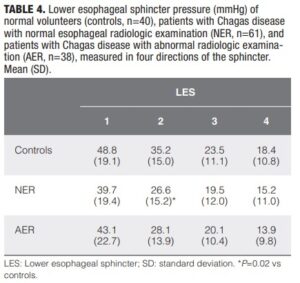HIGHLIGHTS
- Chagas disease changes esophageal motility, causing failed or nonperistaltic esophageal contractions and partial or absent lower esophageal sphincter relaxation. However, these esophageal motility alterations are not present in all patients affected by the disease.
- Upper and lower esophageal sphincter basal pressure could be influenced by changes in esophageal motility.
- No differences were observed in upper or lower esophageal sphincter basal pressure between controls and Chagas disease patients with absent or mild radiologic esophageal involvement.
- Chagas disease patients with constipation had decreased lower esophageal sphincter pressure compared to patients without constipation.
ABSTRACT – Background –
Chagas disease causes digestive anatomic and functional changes, including the loss of the myenteric plexus and abnormal esophageal radiologic and manometric findings. Objective – To evaluate the association of abnormal esophageal radiologic findings, cardiac changes, distal esophageal contractions, and complaints of dysphagia and constipation in upper (UES) and lower (LES) esophageal sphincter basal pressure in Chagas disease patients. Methods – The study evaluated 99 patients with Chagas disease and 40 asymptomatic normal volunteers. The patients had normal esophageal radiologic examination (n=61) or esophageal retention without an increase in esophageal diameter (n=38). UES and LES pressure was measured with the rapid pullthrough method in a 4-channel water-perfused round catheter. Before manometry, the patients were asked about dysphagia and constipation and submitted to electrocardiography and chest radiography. Results – The amplitude of esophageal distal contraction decreased from controls to chagasic patients with esophageal retention. The proportion of failed and simultaneous contractions increased in patients with abnormal radiologic examination (P<0.01). There were no significant differences in UES and LES pressure between the groups. UES pressure was similar between Chagas disease patients with cardiomegaly (n=27, 126.5±62.7 mmHg) and those without it (n=72, 144.2±51.6 mmHg, P=0.26). Patients with constipation had lower LES pressure (n=23, 34.7±20.3 mmHg) than those without it (n=76, 42.9±20.5 mmHg, P<0.03). Conclusion – Chagas disease patients with absent or mild esophageal radiologic involvement had no significant changes in UES and LES basal pressure. Constipation complaints are associated with decreased LES basal pressure. Keywords – Chagas disease; esophageal achalasia; deglutition disorders; esophageal sphincter, upper; esophageal sphincter, lower.
AUTORES
Roberto Oliveira DANTAS*



